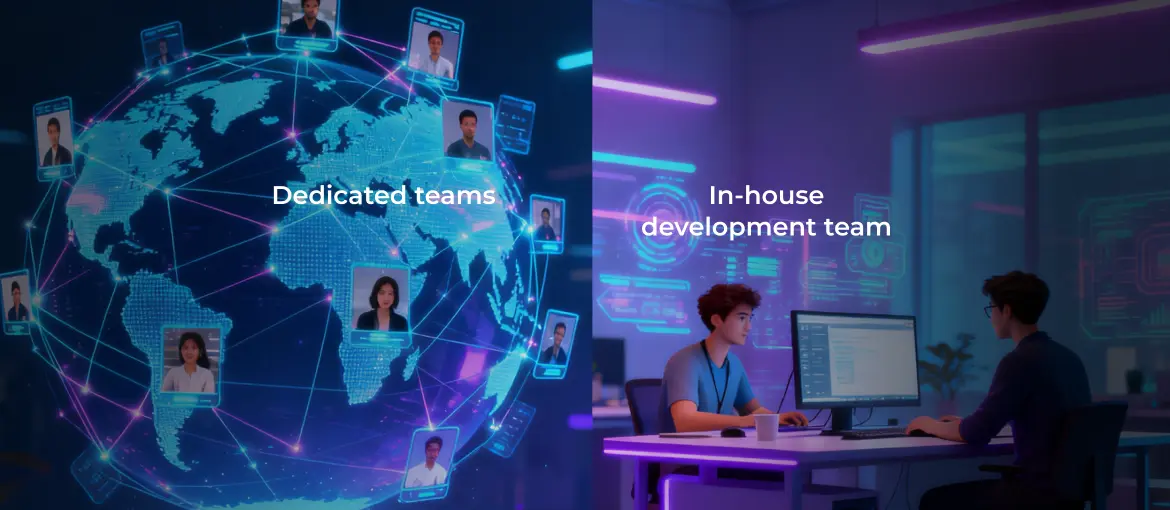- 66% of U.S. companies outsource at least one department, confirming that external development partnerships are now a standard scaling strategy.
- 40% of organizations plan to increase their outsourcing investments.
- 67% of executives now adopt outcome-based outsourcing models, shifting from traditional staff augmentation toward results-driven partnerships.
Knowing how to choose a software development partner has become a critical business skill. A strong tech partnership goes beyond short-term delivery — it creates a lasting operational advantage. The right software development partner extends your engineering capability, stabilizes delivery, and provides access to specialized skills exactly when you need them without the cost and friction of hiring full-time staff.
This guide walks through how to evaluate and select a development partner in a way that strengthens your business, not just fills a staffing gap.
Why choosing the right software development partner matters
Your software partner has a direct influence on how quickly you can execute, how consistently you deliver, and how confidently you can scale. A strong partner aligns technical decisions with business goals, brings clarity to planning, and integrates smoothly with your internal team. When that alignment is in place, delivery becomes predictable, knowledge flows both ways, and product improvements compound over time.
What goes wrong when the partnership is misaligned? Issues rarely appear all at once. They start with unclear ownership, slipped timelines, or uneven communication. Over time, these small gaps accumulate into rework, rising costs, and technical debt that slows every future release. Instead of enabling growth, the partnership becomes a drain on time and leadership attention. The cost isn’t just financial — it affects momentum and market responsiveness.
For a detailed breakdown of software development costs to help inform your decision, check out AgileEngine’s software development cost guide.
When do you need a software development partner?
You need a software development partner when your technical scope, delivery timelines, or growth goals exceed what your internal team can realistically manage. Let’s review in detail the common scenarios where an external partner can provide critical support.
Lack of in-house resources and challenges to scale
Many startups and growing businesses operate with lean teams focused on core functions. When development demands exceed available bandwidth, projects can stall and opportunities may be lost. Building an in-house team to meet these demands often takes months—time that fast-moving markets don’t allow. A software development partner can provide on-demand expertise, workforce stability, and rapid scaling, allowing your team to meet critical deadlines without burnout or costly hiring cycles. Resources can be ramped up or down based on product cycles, funding stages, or seasonal demand, keeping operations lean, responsive, and delivery velocity steady.
Need for on-demand resources
Sometimes, speed is the differentiator between seizing a market opportunity and losing it. If regulatory deadlines, investor milestones, or competitive launches tighten your delivery window, a partner can deploy specialists immediately to meet those time-sensitive goals. It’s an efficient way to deliver under pressure without compromising internal focus.
Talent for new markets or technologies
Adopting emerging technologies like AI, blockchain, cloud-native infrastructure, or low-code platforms requires skills that most internal teams can’t build overnight. A strong development partner brings ready-to-deploy expertise across these domains, reducing your time-to-adoption and risk of technical missteps.
They also introduce best practices, governance models, and proven architectures that help your team absorb new technologies faster, avoiding common pitfalls during transformation.
Delivering PoCs or MVPs quickly
When speed and validation matter more than scale, partnering for proofs of concept (PoCs) or minimum viable products (MVPs) is often the most efficient route. An experienced partner can rapidly transform an idea into a working prototype, enabling you to test assumptions and gather market feedback before investing heavily in full development.
This approach helps startups and innovation teams reduce time-to-insight while keeping costs contained and internal teams focused on core strategy.
Offloading or increasing efficiency
Established organizations often face a different challenge: legacy systems, slow release cycles, or tech debt that limits innovation. A software partner can help modernize outdated infrastructure, implement automation, and optimize workflows while freeing internal teams to focus on product strategy and customer impact.
Challenges and risks in choosing a development company
Selecting the right development partner requires a complex evaluation of alignment, capability, and trust. The process is increasingly difficult in a crowded global market where differentiation is often more cosmetic than real. The following challenges represent the most common risks organizations face when choosing a software development company.
Market saturation and vendor lookalikes
The software outsourcing market is flooded with thousands of vendors offering similar claims: “agile processes,” “senior engineers,” and “end-to-end delivery.” Yet behind these identical marketing pitches, capabilities vary dramatically.
Mitigation: prioritize evidence over appearance. Request client references from your specific industry or start with a short pilot project to see how the team performs day-to-day.
Misalignment of business and product/engineering goals
Even technically competent teams can derail a project if they don’t understand the business model behind it. A product’s success often hinges on how effectively the tech team internalizes market context, monetization goals, and end-user needs.
Mitigation: choose partners who engage in discovery sessions and product strategy discussions before estimating. A good vendor asks “why” as much as “how,” aligning engineering priorities with measurable business outcomes rather than technical vanity metrics.
The difficulty of evaluating quality, work ethic, and skills
One of the hardest parts of vendor selection is assessing skills you can’t independently validate. Non-technical founders or lean internal teams often lack the capacity to assess code quality, architectural decisions, or engineering discipline.
Mitigation: look for objective proxies — GitHub contributions, open-source participation, published technical content, and references from technical stakeholders. Alternatively, consider using technical due diligence services or engaging a temporary CTO consultant to vet candidates. A partner’s hiring process can also reveal their standards: if they can’t articulate how they screen developers, that’s a red flag.
Communication and culture gaps
Cultural misalignment and inconsistent communication styles can erode trust faster than technical issues. Differences in time zones, decision-making norms, and feedback styles often lead to misunderstandings that delay delivery or introduce defects.
Mitigation: during early collaboration, test communication rhythms — daily standups, sprint reviews, async documentation. Evaluate how clearly and transparently the partner communicates uncertainty or blockers. Favor teams that proactively document and clarify decisions rather than reactively respond to issues.
Ownership and intellectual property risks
Not all vendors have mature legal or operational frameworks for IP protection. In regions with weak IP enforcement, companies risk losing ownership of their codebase or seeing proprietary ideas reused elsewhere.
Mitigation: ensure contracts clearly state work-for-hire ownership, source code access, and IP transfer clauses. Use private repositories, NDAs for all contributors, and require visibility into subcontracting arrangements. A credible partner will already have these safeguards standard in their agreements.
Post-launch abandonment
Many development companies focus on delivery, not longevity. Once the MVP or first release is deployed, support typically evaporates, leaving clients without maintenance coverage, performance monitoring, or continuity planning.
Mitigation: before signing, define post-launch responsibilities in writing, including SLAs, response times, bug-fix policies, and knowledge transfer requirements. A true partner sees maintenance as part of the product lifecycle, not a separate upsell.
Key criteria to evaluate a software development partner
The strongest software development partners combine deep technical competence with organizational maturity — a balance that protects your delivery pipeline and your long-term innovation capacity. Here’s what to look for to make the right vendor choice.
Talent depth and geographical coverage
A development company’s true strength lies in the quality, not the quantity, of its engineers. Evaluate whether they draw from an active, curated network of senior talent or simply access a broad freelance pool. Mature organizations maintain stable teams across multiple regions, providing both continuity and flexibility while minimizing single-point dependencies.
Industry presence and track record
Years in business alone don’t guarantee reliability — patterns of delivery do. Look for a consistent history of long-term client engagements and projects similar in scope and complexity to yours. Vendors who have weathered market shifts and technology transitions tend to bring tested methodologies and resilient teams.
Technical expertise and relevant experience
Breadth of service is less important than depth in the domains that matter to you. Evaluate whether the partner has demonstrable expertise in your technology stack, architecture model, and compliance environment. Genuine expertise shows up in reusable components, internal knowledge bases, and public contributions — not just in marketing decks.
Problem-solving ability
A strong partner doesn’t just execute requirements; they anticipate risks and propose alternatives. Review how they’ve handled unclear scopes or project pivots in past engagements. The best vendors combine technical agility with business judgment — translating ambiguity into structured action.
Industry knowledge and proven results
Beyond tech, a capable partner understands your operational realities — regulations, go-to-market cycles, and customer behavior. This industry fluency translates into better product decisions and faster execution because less time is wasted explaining context. Ask for examples of measurable outcomes: efficiency gains, time-to-market improvements, or cost reductions achieved for clients like you.
Communication and cultural fit
Product success depends on how well teams communicate, make decisions, and share accountability. The best software partners establish a collaboration rhythm that blends seamlessly with yours by combining transparency, proactive updates, and empathy for how your team works.
During early conversations, observe how they handle ambiguity, feedback, and scheduling. Strong partners anticipate needs, flag blockers early, and document outcomes clearly.
Cultural fit isn’t about identical work styles, but about mutual respect and adaptability. When teams align on values, pace, and ownership, delivery becomes smoother and innovation compounds naturally.
Team structure and transparency
Knowing who will work on your project matters as much as how. Ask to see actual team compositions and seniority levels, not just roles on paper. Transparent partners explain their escalation paths, delivery ownership, and review checkpoints — all signals of internal discipline and accountability.
Collaboration models
A good vendor adapts its engagement model to your needs — whether through staff augmentation, managed services, or end-to-end delivery. Look for clarity about boundaries of responsibility, handoff points, and performance metrics. The model itself is less important than how well it integrates with your internal processes.
Pricing model and cost clarity
Transparent pricing is a proxy for operational maturity. Ambiguous estimates often conceal undefined scope or lack of delivery planning. Choose partners who provide itemized cost structures, clearly defined change procedures, and open access to budget tracking tools.
Project management methodology
Methodologies like Agile or Scrum only add value when applied with discipline. Ask how sprints are structured, how velocity is tracked, and how retrospectives inform improvement. Mature partners can demonstrate data-driven adjustments rather than generic claims of “agility.”
Code quality, security, and compliance
Software quality isn’t subjective — it’s measurable through automated testing coverage, peer review policies, and adherence to recognized standards (e.g., ISO 27001, GDPR, HIPAA). A credible vendor treats compliance as built-in governance, not an afterthought, and documents its controls proactively.
Post-launch maintenance and support
The strongest software partnerships evolve with your product. Beyond reactive maintenance, a mature vendor helps you plan for product evolution: optimizing performance, refining UX based on user feedback, and supporting new feature rollouts.
Look for partners who integrate monitoring, performance analytics, and continuous improvement cycles into their post-launch process. This ensures your software adapts to market shifts and remains reliable under scaling demands.
13 essential questions to ask before signing

Choosing a software development partner is less about the pitch and more about how they think. The right questions reveal whether a company can execute reliably, collaborate effectively, and scale with you as priorities evolve. Below are 13 questions every business should ask — and what their answers should tell you.
1. What experience can you demonstrate with similar projects and industries?
A vendor’s past work shows how they’ll handle yours. Look for direct parallels, not generic case studies. If you’re a fintech company, ask for examples of products that met compliance or data security requirements. A partner who can speak fluently about the challenges and success metrics of your sector will need less ramp-up time and make fewer strategic missteps.
2. Can you provide client references or testimonials?
References tell the story behind the portfolio. Go beyond surface praise and ask former clients about real delivery moments — how the team handled delays, changes in scope, or unexpected risks. Reliable partners encourage these conversations. If they hesitate, take note.
3. What is your estimate for this project, and how did you arrive at it?
A transparent estimate should read like a roadmap. Ask for a breakdown: discovery, development, testing, and post-launch support. Mature vendors explain assumptions and dependencies, showing they understand the problem before they price it. When estimates sound too smooth or too fast, it often means they skipped the thinking.
4. How do you ensure project continuity and security?
Continuity is often the difference between a smooth delivery and a stalled release. Ask what happens if a key engineer leaves or if an outage occurs. Partners with robust documentation, version control, and backup policies can replace talent without losing momentum. If they mention encryption, access policies, and source control audits, you’re dealing with an organization that understands operational risk.
5. What solutions, services, and technologies do you specialize in?
Breadth sounds impressive until you need depth. Good vendors are specific about where they excel — say, cloud-native SaaS or AI-driven analytics — and can explain why those areas align with your goals. For instance, a team focused on AWS microservices will bring different insights than one built around mobile-first products.
6. How quickly can you source talent for my project?
Speed is valuable only if it doesn’t compromise standards. A vendor who can mobilize engineers within two weeks likely maintains a vetted bench and a refined hiring funnel. Ask how they balance urgency with quality. If they rely entirely on recruiting “just in time,” delivery risks rise.
7. How do you select, screen, and retain talent throughout the engagement?
A project is only as stable as the people behind it. Ask how candidates are tested and how the company keeps them motivated. For example, a vendor who invests in technical mentorship or internal certifications will retain stronger developers over time. Consistency in the team reduces rework, knowledge loss, and delivery delays.
8. How do you manage time zone differences and bridge communication barriers?
Distributed work succeeds when communication is structured. Ask whether they assign local delivery managers or align working hours for overlap. The best firms integrate asynchronous tools like Loom or Notion with regular syncs. A partner that adapts to your rhythm — not just theirs — reduces friction from day one.
9. How do you ensure stakeholder alignment, quality, and timely delivery?
This question tests discipline. Look for specific governance methods, such as sprint demos, retrospectives, quality gates, and KPI reviews. Strong partners treat delivery like an ongoing negotiation between business value and technical feasibility. When they speak in metrics, not platitudes, you can trust their execution.
10. Which collaboration and issue-tracking tools do you use?
Transparency starts with shared tools. Whether it’s Jira, ClickUp, or Trello, you should have direct visibility into progress, blockers, and dependencies. If a vendor prefers to communicate through ad hoc updates or spreadsheets, confusion is likely to arise later. Teams that operate in the open tend to deliver in the open.
11. How do you handle scope changes and risk mitigation?
Every project evolves. What matters is how a vendor manages that evolution. Ask how they document changes, estimate added effort, and communicate trade-offs. A mature team will share examples of how they adapted scope without compromising deadlines or quality — proof that they can remain flexible without losing control.
12. How do you approach transparency throughout the engagement?
Transparency isn’t just about updates, it’s about attitude. The best partners volunteer bad news early and explain their reasoning clearly. Ask to see sample reports, sprint summaries, or risk logs. A vendor who shares data openly is easier to trust when the stakes get high.
13. How do you handle knowledge transfer and project handoff after completion?
The end of a contract shouldn’t mean the end of clarity. A strong partner documents everything: infrastructure setup, API keys, deployment scripts, and architecture diagrams. Before signing, ask what materials you’ll receive at handoff. Think of it as ensuring you can keep driving even after they’ve left the vehicle.
Where to find software development partners
The market for outsourcing and software development services is vast — so vast that typing “hire software developers” into Google returns millions of results. Choice overload is real. To make sense of it, focus your search across three reliable channels: verified listings, professional networks, and trusted communities.
Below is a breakdown of where to look and how to approach each.
| Source | Description | How to use effectively |
|---|---|---|
Verified directories and rankings sites | Platforms like Clutch, The Manifest, GoodFirms, and IT Firms aggregate verified client reviews, service portfolios, and project data. They’re useful for comparing vendor maturity and reading first-hand client feedback. | Look beyond overall ratings. Read the reviews for details on communication, post-launch support, and project complexity. Verified reviews mentioning long-term cooperation are stronger indicators of quality than one-off testimonials. |
Professional and business networks | LinkedIn remains the go-to network for discovering vetted engineering companies and talent leaders. Platforms like Xing (Europe) or AngelList (startups) can also show credible vendors. | Search by keywords such as “dedicated development team,” “nearshore software partner,” or specific tech stacks (e.g., React development, AWS DevOps). Review mutual connections and endorsements; direct introductions often yield faster, higher-quality matches than cold outreach. |
Local and peer communities | CTO roundtables, industry Slack groups, accelerator networks, or regional tech events can be surprisingly effective for finding reliable partners. Recommendations from peers — especially those who’ve completed similar projects — might carry more weight than online reviews. | Ask for referrals on trusted channels (LinkedIn groups, niche Discord or Slack communities, alumni networks). When seeking advice, share context: industry, tech stack, and budget range. The more specific your request, the better the recommendations. |
How to structure a successful partnership
A successful collaboration with a software development partner is about alignment, transparency, and mutual accountability. The best outcomes come when both sides operate as one cohesive team, working toward shared goals with a clearly defined scope, measurable KPIs, and open communication. Here’s how you can structure a successful partnership:
1. Clearly define scope, budget, and timeline — but stay adaptable
Before development starts, outline exactly what success looks like. Define the project scope, budget parameters, and key delivery milestones, and ensure that stakeholders on both sides formally approve them. This clarity prevents misalignment and helps maintain accountability throughout the engagement.
That said, software projects rarely follow a perfectly linear path. Market shifts, customer feedback, or internal strategy changes may require you to adjust direction. Instead of rigid contracts, use flexible frameworks that allow for scope reviews and controlled iteration.
Example: a logistics platform might start by developing route optimization features but pivot mid-project to include AI-driven forecasting after user validation. A partner experienced in adaptive delivery makes that shift smooth, not costly.
2. Set clear KPIs and deliverables
Well-defined KPIs make collaboration tangible. Move beyond general statements like “on-time delivery” — instead, measure sprint velocity, code review quality, defect ratios, or user activation rates. Clear deliverables such as MVP releases, architecture diagrams, or QA test plans make progress visible and verifiable.
Shared KPIs help both sides maintain focus on business value rather than output alone — ensuring that each sprint contributes to measurable outcomes.
3. Establish a consistent communication rhythm
Predictable communication prevents surprises. Regular sprint reviews, weekly standups, and roadmap checkpoints create a steady flow of updates. Combine these with asynchronous channels like Jira, Confluence, and Slack to accommodate time zone differences and minimize friction.
Assigning a delivery owner or product lead on your side ensures accountability and speeds up decision-making. This rhythm — structured yet flexible — is one of the clearest differentiators between productive and frustrating partnerships.
For more ideas on bridging cultural and time-zone gaps, see our nearshore vs. offshore comparison.
4. Build feedback loops and agile iterations
Continuous feedback transforms collaboration from transactional to evolutionary. Incorporate retrospectives at the end of each sprint, encourage developers to present demos, and capture stakeholder feedback in structured sessions.
The best partners don’t just follow instructions — they co-create value, offering proactive insights on architecture, UX, and process optimization. Agile iteration ensures your product improves continuously, not just after a release.
5. Choose the right management approach
Micromanagement kills creativity, but a lack of structure leads to drift. The solution lies in balanced oversight: define a single owner on your side responsible for delivery coordination and decision-making, and establish clear escalation paths for risks or blockers.
Example: a company scaling its product team can assign a product owner internally, supported by a vendor-side delivery manager who handles day-to-day progress. This dual-ownership model keeps teams autonomous yet aligned.
6. Foster mutual respect and shared ownership
The most successful partnerships thrive on respect and inclusion. Treat your external engineers as an extension of your internal team — invite them to product demos, team retros, and key Slack channels. Recognition, transparency, and open communication foster shared responsibility and long-term commitment.
2025 outsourcing trends: AI-augmented development teams
AI is changing how external teams work together through small, structural efficiencies that compound over time. At the 2025 McKinsey R&D Leaders Forum, several companies reported cutting weeks from development timelines simply by integrating generative models into their documentation, code review, and design validation workflows. The outcome wasn’t a replacement of engineers but a redistribution of focus: teams spent less time clarifying specs and more time iterating on solutions.
For outsourcing partnerships, that shift matters. Vendors that have operationalized AI into their pipelines deliver with more consistency because project noise gets resolved earlier in the process.
The distinction between an average vendor and a strong one now comes down to how well AI is integrated into day-to-day delivery, rather than how loudly it’s marketed. When evaluating a software partner, look beyond claims of “AI capability” and ask about real workflow integration: how requirements are documented, how testing cycles are automated, and how version control is managed. The vendors treating AI as infrastructure rather than a feature are already showing better delivery discipline and higher client retention.
What makes AgileEngine a great software development partner
AgileEngine consistently stands out for our client satisfaction, global talent network, and flexible engagement models that adapt to every project stage.
Trusted by high-profile clients worldwide
With a 5-star rating on Clutch, AgileEngine has earned the trust of Fortune 500 enterprises and fast-scaling startups alike. Our partnerships span industries such as fintech, media, healthcare, and logistics — sectors where reliability and innovation are equally critical.
This level of trust stems from consistent delivery, transparent collaboration, and shared ownership of results. Many clients begin with a pilot project and continue into long-term digital transformation engagements, a testament to AgileEngine’s ability to scale relationships and deliver lasting value.
A reliable global talent network
AgileEngine operates across 15+ international delivery hubs in North America, Latin America, Europe, and Asia, giving clients both time-zone flexibility and access to top regional engineering talent. This distributed model enables smooth collaboration and ensures continuity across global projects — whether you’re building a real-time trading platform in New York or scaling a SaaS product in Berlin.
Flexible engagement models for every stage of growth
Every business needs a model that aligns with its pace, goals, and level of maturity. AgileEngine provides full coverage — from staff augmentation and dedicated development teams to end-to-end software delivery. Our expertise extends across full-stack web and mobile development, AI and data engineering, UX/UI design, QA automation, and DevOps.
For example, a startup might begin with a few backend specialists through staff augmentation, later evolving into a full, managed team that handles product strategy, design, and development. AgileEngine’s models are all about scaling seamlessly as needs change.
A partnership mindset focused on outcomes
AgileEngine’s success lies in treating every engagement as a strategic collaboration, not a transaction. Our teams align with clients’ goals, embedding metrics for quality, velocity, and ROI into delivery from day one.
By maintaining transparent processes, clear communication, and measurable results, AgileEngine acts as an extension of its clients’ teams, helping them build scalable systems, better user experiences, and technology foundations that drive growth.
Conclusion
Selecting a software development partner is a strategic decision that shapes both the pace and resilience of your digital operations. The strongest collaborations are built on clarity, evidence, and measured trust. Technical capability must be matched by process maturity and communication discipline.
A well-chosen partner extends your internal capacity while preserving control and strategic direction. They enable consistent delivery, transparent governance, and technical foundations that remain stable under growth. In an environment defined by rapid change, that combination is what separates tactical outsourcing from durable partnership.
AgileEngine helps companies deliver reliable, scalable software through partnerships grounded in technical depth and shared accountability.
FAQs
Timelines vary depending on how structured your evaluation process is. When the search is organized around a clear scope, vendor matrix, and verified references, most companies can identify a shortlist within two to four weeks. Delays usually come from unclear requirements or a lack of internal alignment about priorities. Efficiency in selection comes from clarity, not speed.
An effective RFP defines the problem, not just the desired features. It should outline business objectives, expected outcomes, constraints, and success metrics. Include technical context such as architecture preferences or compliance needs, but keep it concise enough to encourage engagement. Vendors with real expertise will use the RFP as a framework for discovery, not as a fixed checklist.
Technical skill matters, but governance and communication define long-term success. The partner’s ability to manage scope, maintain transparency, and document progress consistently will determine whether collaboration scales. In practice, stability and predictability are stronger indicators of value than price or team size.
Before engagement ends, confirm delivery of all documentation, credentials, and repository access. Ownership should be contractual, not assumed. A post-launch knowledge transfer session, combined with technical documentation and architectural maps, secures continuity and reduces dependency on individual contributors.












